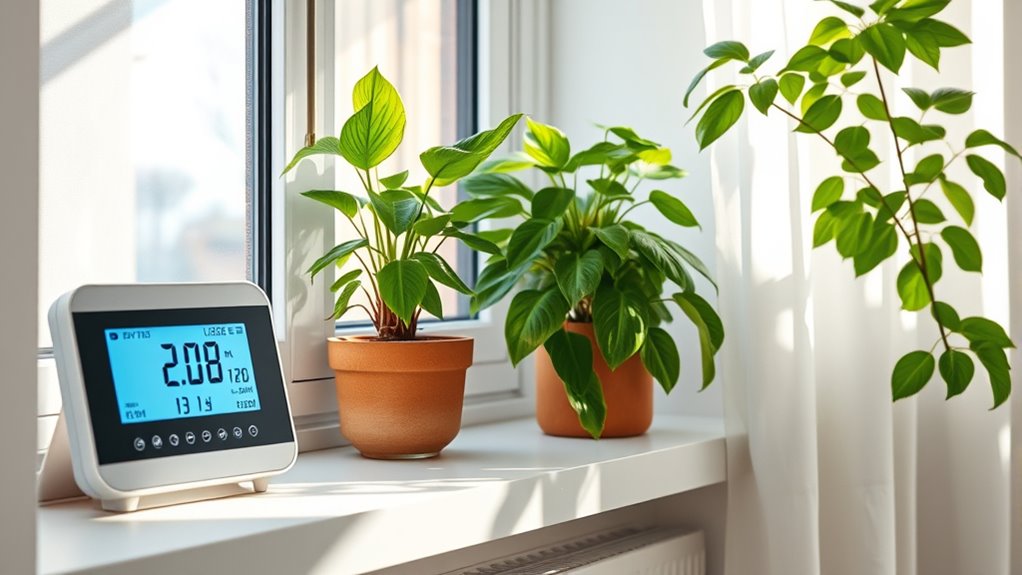To prevent mold and promote healthy indoor air, keep humidity levels between 30% and 50%. Use a hygrometer to monitor moisture, and regularly maintain your dehumidifier by cleaning filters and emptying water tanks. Apply mold-resistant paints in high-humidity areas and ensure proper ventilation with exhaust fans. Consistently combining these steps creates a drier, mold-free environment. Continue exploring ways to improve your home’s humidity control for lasting health benefits.
Key Takeaways
- Maintain indoor humidity between 30% and 50% using a hygrometer to prevent mold growth.
- Regularly clean and empty the dehumidifier to ensure effective moisture control.
- Apply mold-resistant paints in high-humidity areas like bathrooms and basements.
- Use ventilation fans and exhaust systems to reduce excess moisture in moisture-prone spaces.
- Perform ongoing maintenance and combine it with mold-resistant products and proper ventilation for a healthy home.

Have you ever noticed how uncomfortable it feels when the air is too dry or too damp? That imbalance can lead to a host of issues, especially mold growth, which can impact your health and home’s integrity. To keep indoor air healthy, maintaining proper humidity levels is essential, and one effective way to do that is through proper dehumidifier maintenance. If you own a dehumidifier, make sure you’re regularly cleaning the filters and emptying the water tank to ensure it functions efficiently. Neglecting maintenance can reduce its ability to control moisture, allowing humidity to creep up and create an environment ripe for mold. A well-maintained dehumidifier not only keeps the air comfortable but also helps prevent mold spores from settling and multiplying on surfaces.
Regularly clean filters and empty water tanks to keep your dehumidifier effective and prevent mold growth.
In addition to mechanical solutions, applying mold resistant paints can offer an extra layer of protection. These paints contain antimicrobial agents that inhibit mold growth on walls and ceilings, especially in high-humidity areas like bathrooms and basements. When you paint with mold resistant products, you’re actively discouraging mold spores from taking hold and spreading, reducing the need for frequent cleaning and repainting. Combining this with proper ventilation and humidity control creates a hostile environment for mold, safeguarding your indoor air quality and your health. Maintaining optimal humidity levels is also crucial, as it helps prevent mold from thriving.
Understanding the importance of humidity levels can also guide you in making smarter choices. Keep your indoor relative humidity between 30% and 50%. Use a hygrometer to monitor this, and adjust your dehumidifier accordingly. During humid months, you might need to run your dehumidifier more frequently, while in dry seasons, you can scale back. Remember, a dehumidifier isn’t just a one-time setup; it’s a constant partner in maintaining a healthy environment. Regular upkeep, including cleaning filters and checking for mold growth around the unit, ensures it continues to operate at peak efficiency.
Finally, consider the overall design of your space. Use mold resistant paints on walls prone to moisture exposure, and ensure your home has proper ventilation—especially in bathrooms and kitchens. Vent fans and exhaust systems can substantially reduce excess humidity, making your space less hospitable to mold. By combining diligent dehumidifier maintenance, strategic use of mold resistant paints, and good ventilation habits, you set yourself up for a healthier, mold-free home environment. Protecting your indoor air quality isn’t a one-time task, but a continuous effort that pays off in comfort, safety, and peace of mind.
Frequently Asked Questions
How Does Humidity Affect Allergy Symptoms Indoors?
You may notice allergy symptoms worsen when indoor humidity is high because it promotes mold growth and increases airborne allergens like dust mites. Mold thrives in damp environments, releasing spores that trigger allergies. Keeping humidity levels between 30-50% helps reduce mold and airborne allergens, making your indoor air healthier. Proper humidity control minimizes allergy symptoms, so you breathe easier and enjoy a more comfortable living space.
What Are the Best Dehumidifiers for Large Spaces?
You should choose a dehumidifier with a high capacity, ideally rated for large spaces over 1,500 square feet. Look for models with strong dehumidifier capacity to handle extensive areas efficiently. Prioritize energy efficiency to save on power costs while maintaining ideal humidity levels. Brands like Frigidaire and Santa Fe offer reliable, energy-efficient options suitable for large rooms, ensuring your indoor air stays healthy and mold-free.
Can Plants Help Regulate Indoor Humidity Levels?
Yes, plants can help regulate indoor humidity levels by increasing humidity through transpiration, which releases moisture into the air. Their benefits include natural humidity balance and improved air quality. Including houseplants like pothos or ferns can make your space more comfortable, especially in dry environments. Just remember, while plants help maintain humidity, they shouldn’t replace dehumidifiers in areas prone to excess moisture or mold issues.
How Often Should I Check My Home’s Humidity?
You should check your home’s humidity daily—because who doesn’t love a tiny indoor weather forecast? Grab your humidity sensors or moisture meters and make it a quick routine. Ideally, keep levels between 30-50%. If it’s too high or low, adjust as needed. Regular checks help you dodge mold and keep your air healthy—because nobody wants a fungal surprise in their living room!
What Are Quick Fixes for High Humidity During Summer?
To quickly lower high summer humidity, use a dehumidifier and guarantee proper maintenance for ideal performance. Increase summer ventilation strategies by opening windows during cooler parts of the day and using exhaust fans in bathrooms and kitchens. You can also run ceiling fans to promote air circulation. These steps help reduce moisture levels fast, making your home more comfortable and mold-resistant during the hot summer months.
Conclusion
By taking control of your indoor humidity, you’re not just preventing mold—you’re creating a sanctuary where healthy air can thrive. Think of humidity management as the keystone in an arch; when it’s in place, everything else holds steady. Keep your home’s moisture levels balanced, and you’ll enjoy fresher, safer air, like a breath of spring after a long winter. Your efforts today safeguard your comfort and health for years to come.








